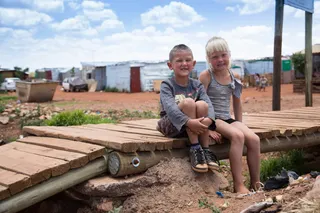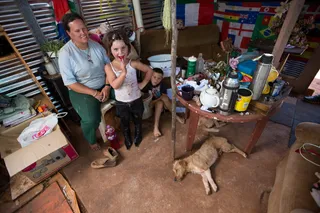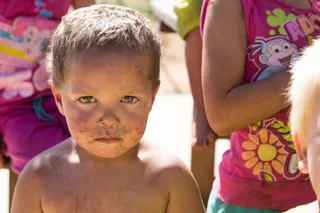Take a Peek Inside South Africa's White Shantytowns
What happens when the government checks stop coming.

1 / 10
Dramatic Changes Since the Fall of Apartheid - Shantytowns have historically been a symbol of the horrendous way Black people were oppressed during Apartheid, but these days, these "squatter camps" are seeing some surprising new residents. Poor white South African families are being forced to live in the way so many Black families did before the fall of the regime in a "white squatter camp" with no power, barely any food or water and inadequate shelter. During Apartheid, the white supremacist regime practically guaranteed Afrikaners employment and housing, but since its collapse in 1994, townships like this have popped up all over the country. Here's a peek inside.(Photo: James Cheadle/Solent News)

2 / 10
The New Poor - A young child bikes along the dirt-path of the shantytown. It is estimated that around 100,000 Afrikaners now live in these dire conditions. (Photo: James Cheadle/Solent News)

3 / 10
Life Inside - With the end of minority rule, maintaining the subsidies that white citizens received became both immoral and logistically impossible. The result was a huge number of white citizens with no jobs, and no safety net.(Photo: James Cheadle/Solent News)

4 / 10
Not Just a White Thing - The number of Black South Africans living in similarly impoverished conditions is huge. (Photo: James Cheadle/Solent News)
Photo By Photo: James Cheadle/Solent News

5 / 10
Makeshift Living - Those living in these Shanytowns live in makeshift shelters like this one. Families are forced to live in povery with very little hope of getting out.(Photo: James Cheadle/Solent News)
Photo By Photo: James Cheadle/Solent News
ADVERTISEMENT

6 / 10
Born This Way - Most of the children who have grown up in these shantytowns can't imagine a different life, as they've never experienced the benefits of the state given to previous generations. (Photo: James Cheadle/Solent News)

7 / 10
No Resources - Poor sanitation and limited health care oftenn lead to the spread of infection and disease in the slums. (Photo: James Cheadle/Solent News)
Photo By Photo: James Cheadle/Solent News

8 / 10
Wrong Side of History - Because of South Africa's history with race and apartheid, these impoverished whites are finding little sympathy from society, who believes they already profited unfairly from the oppressive regime.(Photo: James Cheadle/Solent News)

9 / 10
Overpopulation - With rising rates of poverty and no other options, the Shantytowns are often overcrowded with residents. The newest and poorest arrivals often have to live on the worst quality land.(Photo: James Cheadle/Solent News)
